Analysis of the Effectiveness of ARIMA, SARIMA, and SVR Models in Time Series Forecasting: A Case Study of Wind Farm Energy Production
Abstract
1. Introduction
2. Materials and Methods
2.1. Data Used
2.2. Methods Used
2.2.1. ARIMA
2.2.2. SARIMA
2.2.3. SVR
2.3. Errors
3. Results
3.1. ARIMA
3.2. SARIMA
3.3. SVR
3.4. Monthly Forecasts
3.5. Error Values
4. Discussion
5. Conclusions
Author Contributions
Funding
Data Availability Statement
Conflicts of Interest
References
- Sayed, E.T.; Olabi, A.G.; Alami, A.H.; Radwan, A.; Mdallal, A.; Rezk, A.; Abdelkareem, M.A. Renewable Energy and Energy Storage Systems. Energies 2023, 16, 1415. [Google Scholar] [CrossRef]
- Turco, E.; Bazzana, D.; Rizzati, M.; Ciola, E.; Vergalli, S. Energy price shocks and stabilization policies in the MATRIX model. Energy Policy 2023, 177, 113567. [Google Scholar] [CrossRef]
- Pourasl, H.H.; Vatankhah Barenji, R.; Khojastehnezhad, V.M. Solar energy status in the world: A comprehensive review. Energy Rep. 2023, 10, 3474–3493. [Google Scholar] [CrossRef]
- Hasan, M.M.; Hossain, S.; Mofijur, M.; Kabir, Z.; Badruddin, I.A.; Yunus Khan, T.M.; Jassim, E. Harnessing Solar Power: A Review of Photovoltaic Innovations, Solar Thermal Systems, and the Dawn of Energy Storage Solutions. Energies 2023, 16, 6456. [Google Scholar] [CrossRef]
- Hannan, M.A.; Al-Shetwi, A.Q.; Mollik, M.S.; Ker, P.J.; Mannan, M.; Mansor, M.; Al-Masri, H.M.K.; Mahlia, T.M.I. Wind energy conversions, controls, and applications: A review for sustainable technologies and directions. Sustainability 2023, 15, 3986. [Google Scholar] [CrossRef]
- Helerea, E.; Calin, M.D.; Musuroi, C. Water Energy Nexus and Energy Transition—A Review. Energies 2023, 16, 1879. [Google Scholar] [CrossRef]
- Szostek, K. Estimation of the power of a geothermal energy recovery system that uses a heat exchanger. Renew. Energy 2024, 220, 119616. [Google Scholar] [CrossRef]
- Szostek, R. An estimation of the geothermal energy sources for generating electricity. In Analysis and Simulation of Electrical and Computer Systems, 2nd ed.; Gołębiowski, L., Mazur, D., Eds.; Springer: Cham, Switzerland, 2015; Volume 324, pp. 154–196. [Google Scholar] [CrossRef]
- Michalak, A.; Wolniak, R. The innovativeness of the country and the renewables and non-renewables in the energy mix on the example of European Union. J. Open Innov. Technol. Mark. Complex. 2023, 9, 100061. [Google Scholar] [CrossRef]
- Wang, H.; Lei, Z.; Zhang, X.; Zhou, B.; Peng, J. A review of deep learning for renewable energy forecasting. Energy Convers. Manag. 2019, 198, 111799. [Google Scholar] [CrossRef]
- Kaur, J.; Parmar, K.S.; Singh, S. Autoregressive models in environmental forecasting time series: A theoretical and application review. Environ. Sci. Pollut. Res. 2023, 30, 19617–19641. [Google Scholar] [CrossRef]
- Chodakowska, E.; Nazarko, J.; Nazarko, Ł.; Rabayah, H.S.; Abendeh, R.M.; Alawneh, R. ARIMA Models in Solar Radiation Forecasting in Different Geographic Locations. Energies 2023, 16, 5029. [Google Scholar] [CrossRef]
- Manowska, A.; Rybak, A.; Dylong, A.; Pielot, J. Forecasting of Natural Gas Consumption in Poland Based on ARIMA-LSTM Hybrid Model. Energies 2021, 14, 8597. [Google Scholar] [CrossRef]
- Nokeri, T.C. Forecasting Using ARIMA, SARIMA, and the Additive Model. In Implementing Machine Learning for Finance; Apress: Berkeley, CA, USA, 2021. [Google Scholar] [CrossRef]
- Sirisha, U.M.; Belavagi, M.C.; Attigeri, G. Profit Prediction Using ARIMA, SARIMA and LSTM Models in Time Series Forecasting: A Comparison. IEEE Access 2022, 10, 124715–124727. [Google Scholar] [CrossRef]
- Liu, X.; Lin, Z.; Feng, Z. Short-term Offshore Wind Speed Forecast by Seasonal ARIMA: A Comparison Against GRU and LSTM. Energy 2021, 227, 120492. [Google Scholar] [CrossRef]
- Farsi, M.; Hosahalli, D.; Manjunatha, B.R.; Gad, I.; Atlam, E.-S.; Ahmed, A.; Elmarhomy, G.; Elmarhoumy, M.; Ghoneim, O.A. Parallel Genetic Algorithms for Optimizing the SARIMA Model for Better Forecasting of the NCDC Weather Data. Alex. Eng. J. 2021, 60, 1299–1316. [Google Scholar] [CrossRef]
- Uzair, M.; Shah, I.; Ali, S. An Adaptive Strategy for Wind Speed Forecasting Under Functional Data Horizon: A Way Toward Enhancing Clean Energy. IEEE Access 2024, 12, 68730–68746. [Google Scholar] [CrossRef]
- Alanis, A.Y.; Sanchez, O.D.; Alvarez, J.G. Time Series Forecasting for Wind Energy Systems Based on High Order Neural Networks. Mathematics 2021, 9, 1075. [Google Scholar] [CrossRef]
- Mosavi, A.; Salimi, M.; Faizollahzadeh Ardabili, S.; Rabczuk, T.; Shamshirband, S.; Varkonyi-Koczy, A.R. State of the Art of Machine Learning Models in Energy Systems, a Systematic Review. Energies 2019, 12, 1301. [Google Scholar] [CrossRef]
- Lai, J.-P.; Chang, Y.-M.; Chen, C.-H.; Pai, P.-F. A Survey of Machine Learning Models in Renewable Energy Predictions. Appl. Sci. 2020, 10, 5975. [Google Scholar] [CrossRef]
- Li, Z.; Zuo, A.; Li, C. Predicting Raw Milk Price Based on Depth Time Series Features for Consumer Behavior Analysis. Sustainability 2023, 15, 6647. [Google Scholar] [CrossRef]
- Graf, R.; Zhu, S.; Sivakumar, B. Forecasting river water temperature time series using a wavelet–neural network hybrid modelling approach. J. Hydrol. 2019, 578, 124115. [Google Scholar] [CrossRef]
- Sagheer, A.; Kotb, M. Time series forecasting of petroleum production using deep LSTM recurrent networks. Neurocomputing 2019, 323, 203–213. [Google Scholar] [CrossRef]
- Hamilton, J.D. Time Series Analysis; Princeton University Press: Princeton, NJ, USA, 2020. [Google Scholar]
- Wu, Z.; Pan, S.; Long, G.; Jiang, J.; Chang, X.; Zhang, C. Connecting the dots: Multivariate time series forecasting with deep learning: A survey. Philos. Trans. R. Soc. A 2021, 379, 20200209. [Google Scholar]
- Jamróz, D.; Niedoba, T.; Surowiak, A.; Tumidajski, T.; Szostek, R.; Gajer, M. Application of Multi-Parameter Data Visualization by Means of Multidimensional Scaling to Evaluate Possibility of Coal Gasification. Arch. Min. Sci. 2017, 62. [Google Scholar] [CrossRef][Green Version]
- Izo-nin, I.; Tkachenko, R.; Shakhovska, N.; Lotoshynska, N. The Additive Input-Doubling Method Based on the SVR with Nonlinear Kernels: Small Data Approach. Symmetry 2021, 13, 612. [Google Scholar] [CrossRef]
- Jenkins, G.M.; Box, G.E.P. Time Series Analysis: Forecasting and Control; Holden-Day: San Francisco, CA, USA, 1976. [Google Scholar]
- Awe, O.; Okeyinka, A.; Fatokun, J.O. An Alternative Algorithm for ARIMA Model Selection. In Proceedings of the 2020 IEEE International Conference in Mathematics, Computer Engineering and Computer Science (ICMCECS), Ayobo, Nigeria, 14–16 October 2020; pp. 1–4. [Google Scholar] [CrossRef]
- Vapnik, V.; Golowich, S.; Smola, A. Support vector method for function approximation, regression estimation and signal processing. In Advances in Neural Information Processing Systems 9; MIT Press: Cambridge, MA, USA, 1996. [Google Scholar]
- Ding, S.; Hua, X.; Yu, J. An overview on nonparallel hyperplane support vector machine algorithms. Neural Comput. Appl. 2014, 25, 975–982. [Google Scholar] [CrossRef]
- Shcherbakov, M.V.; Brebels, A.; Shcherbakova, N.L.; Tyukov, A.P.; Jan, T.-S.; Lin, Y.-F. A survey of forecast error measures. World Appl. Sci. J. 2013, 24, 171–176. [Google Scholar]

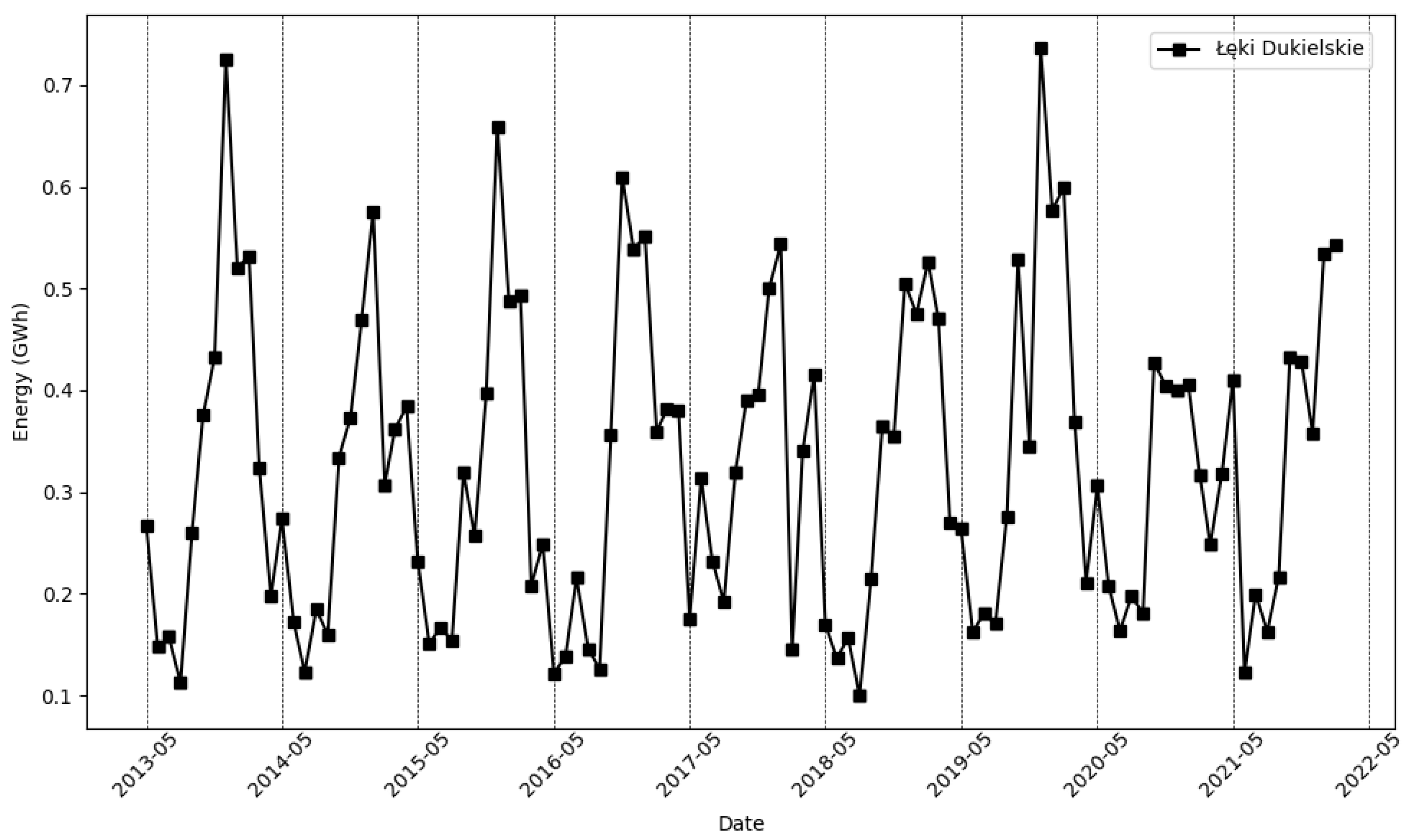
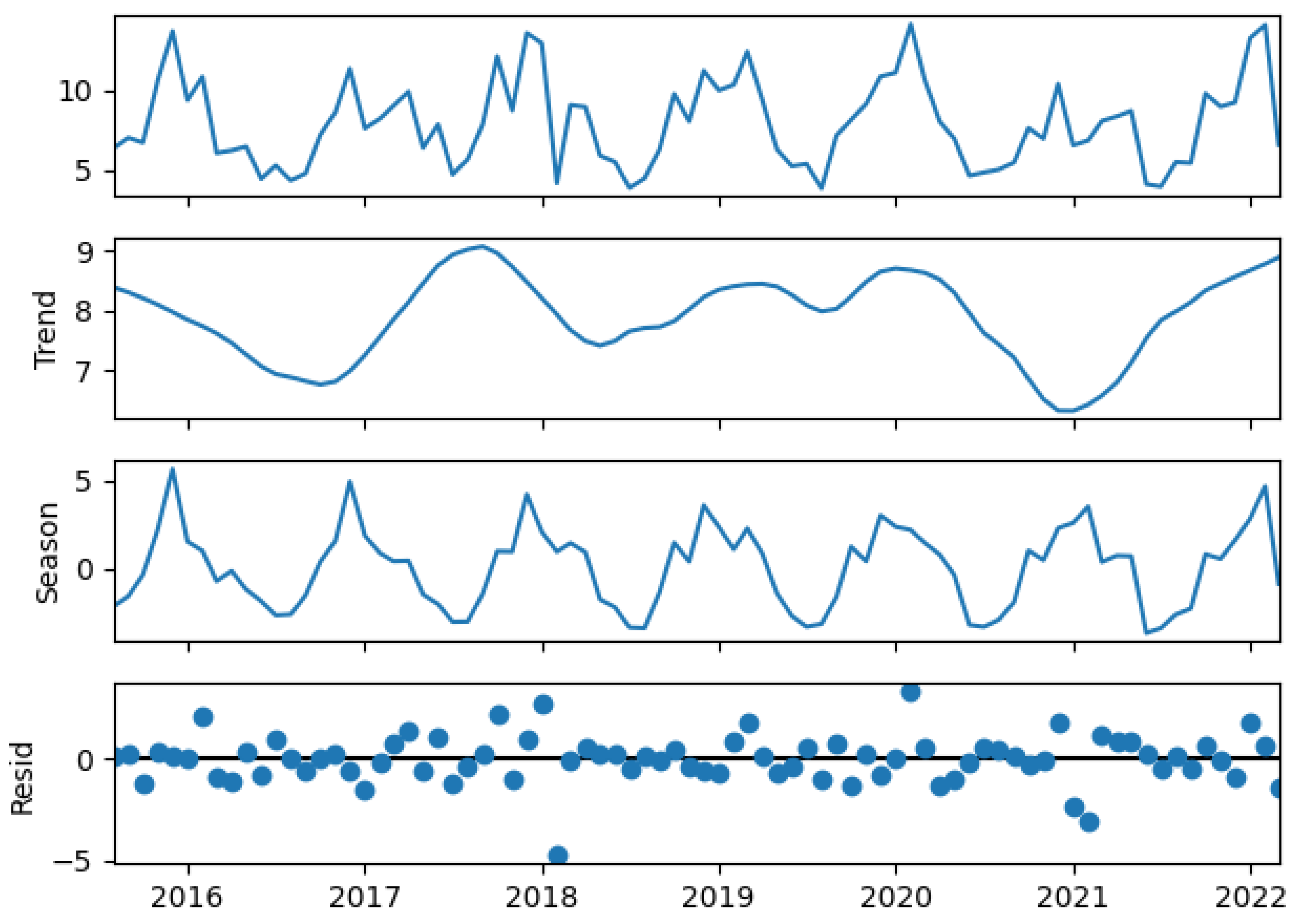
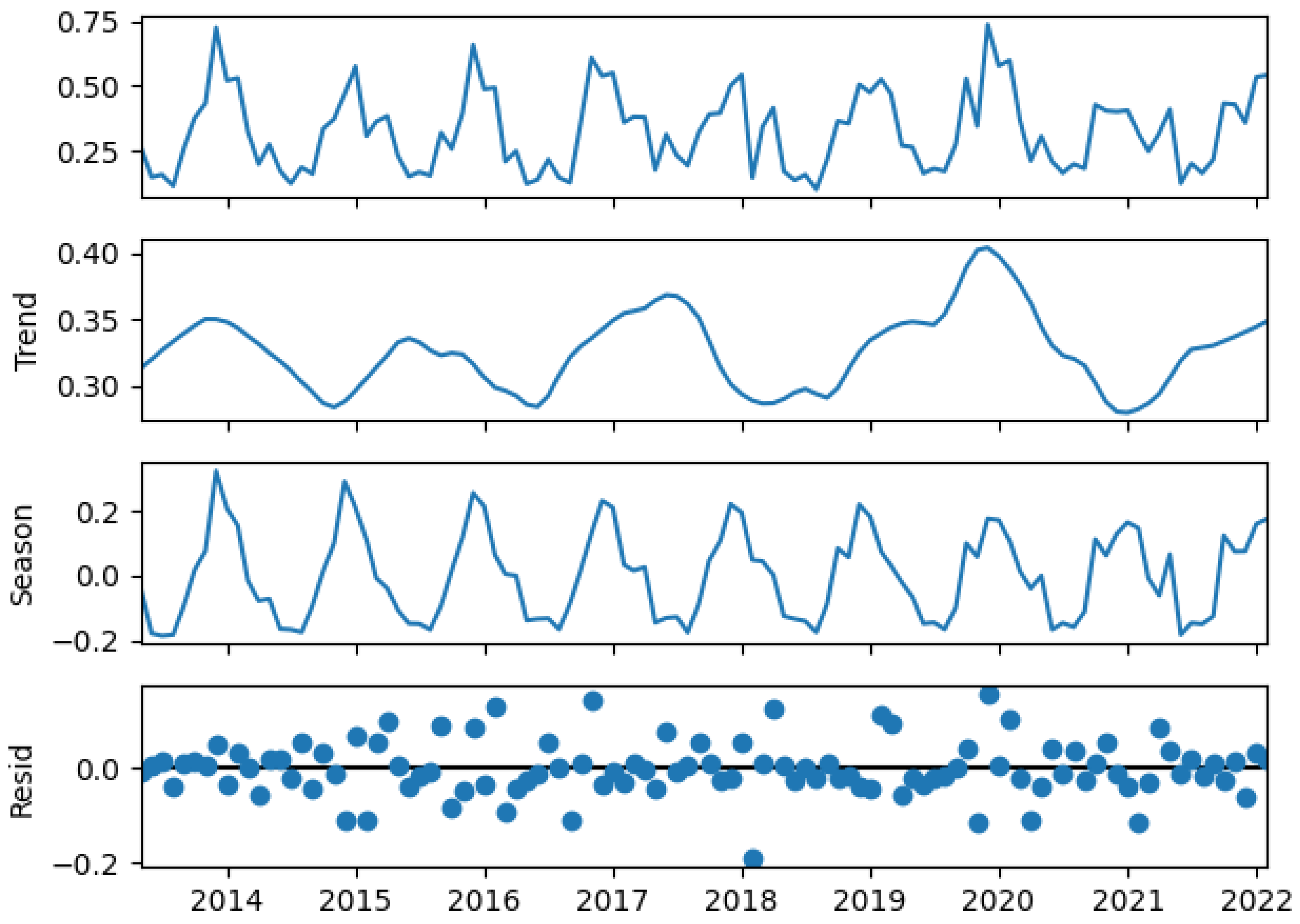

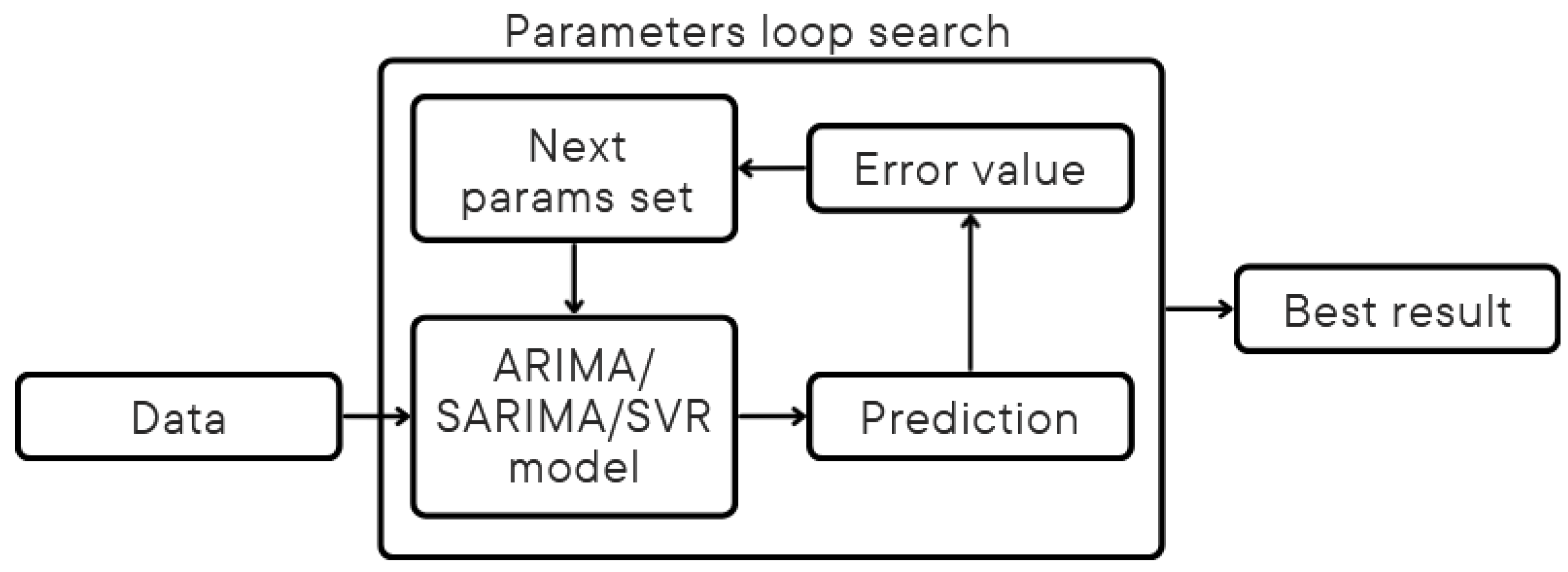

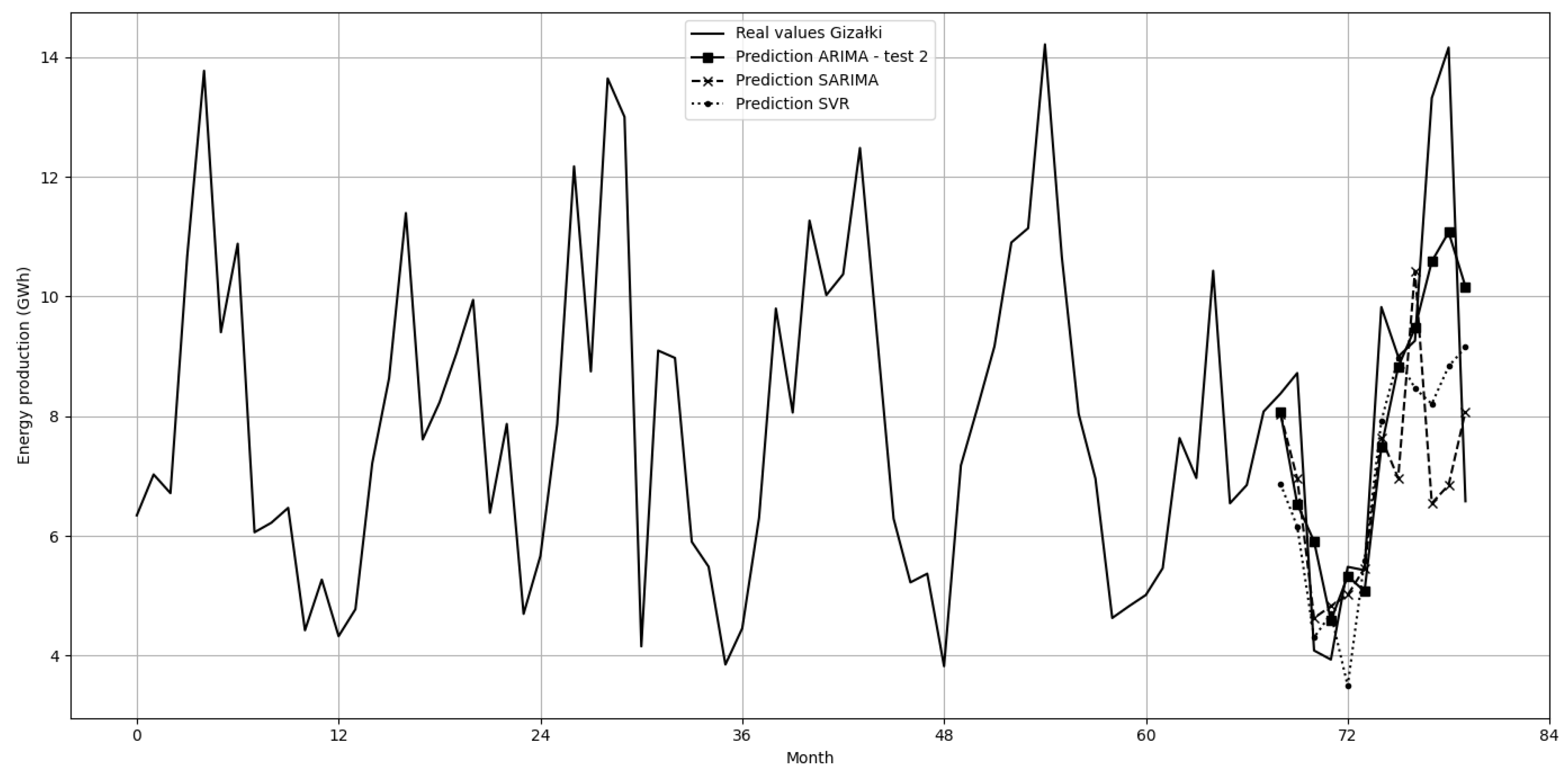

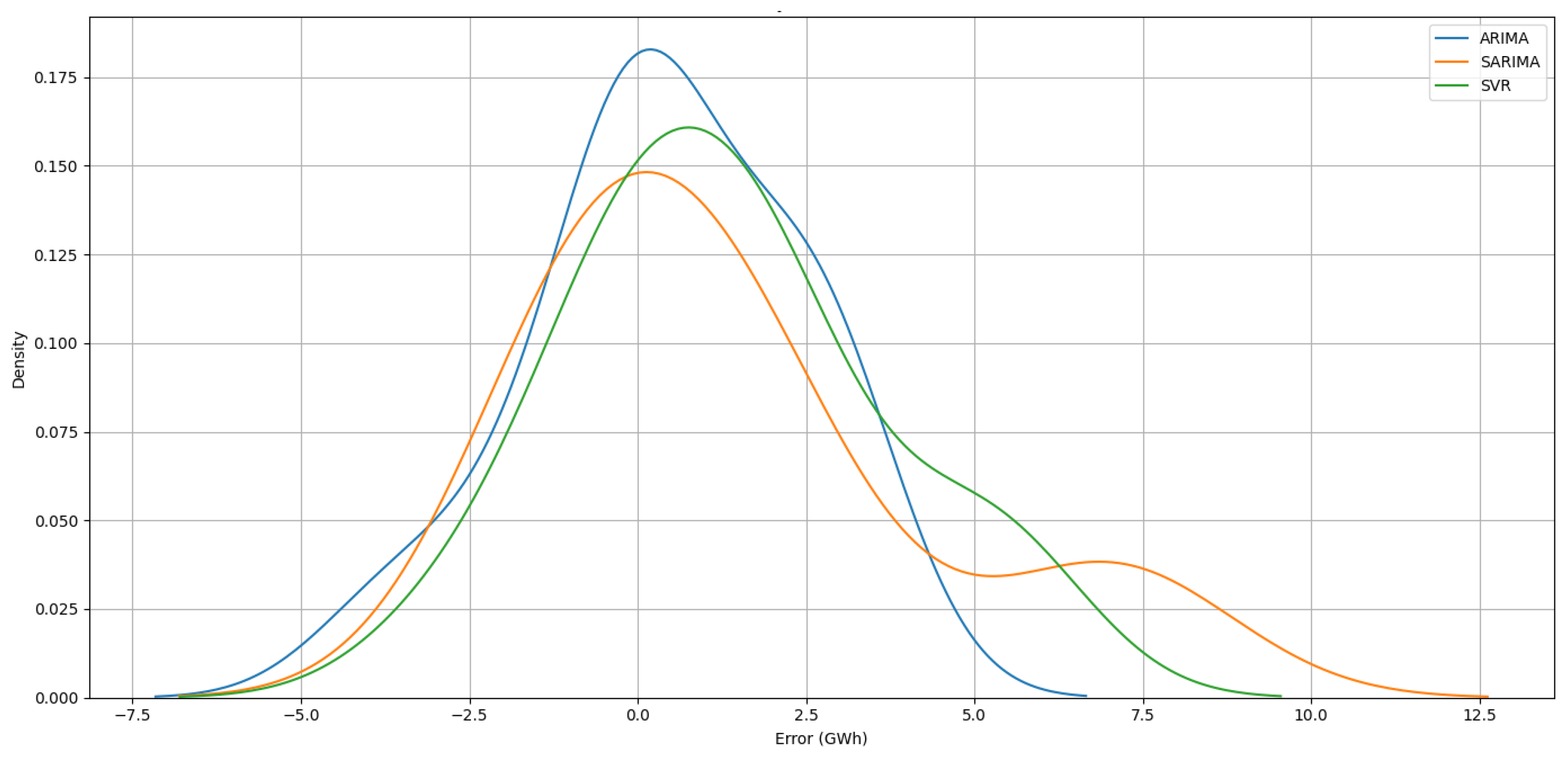

| Parameter | Range | Step | Selected Value Gizałki | Selected Value Łęki Dukielskie |
|---|---|---|---|---|
| p–test 1 | [0–5] | 1 | 4 | 3 |
| D–test 1 | [0–2] | 1 | 0 | 0 |
| q–test 1 | [0–5] | 1 | 4 | 3 |
| p–test 2 | [0–9] | 1 | 7 | 5 |
| d–test 2 | [0–9] | 1 | 0 | 1 |
| q–test 2 | [0–9] | 1 | 6 | 7 |
| Parameter | Range | Step | Selected Value Gizałki | Selected Value Łęki Dukielskie |
|---|---|---|---|---|
| p | [0–5] | 1 | 0 | 1 |
| d | [0–2] | 1 | 0 | 0 |
| q | [0–5] | 1 | 0 | 4 |
| P | [0–2] | 1 | 0 | 2 |
| D | [0–1] | 1 | 1 | 1 |
| Q | [0–2] | 1 | 0 | 0 |
| Parameter | Range | Step | Number of Steps | Selected Value Gizałki | Selected Value Łęki Dukielskie |
|---|---|---|---|---|---|
| C | [−2; 3] | log | 10 | 21.5 | 1.67 |
| ε | [−3; 0] | log | 10 | 0.464 | 0.001 |
| γ | [−3; 2] | log | 6 | 1 | 1 |
| kernel | [‘linear’, ‘poly’, ‘rbf’, ‘sigmoid’] | - | - | ‘sigmoid’ | ‘rbf’ |
| ind_term | [0; 1] | 0.1 | - | 0.6 | 0 |
| Month. | Actual Values | ARIMA Test 1 | ARIMA Test 2 | SARIMA | SVR |
|---|---|---|---|---|---|
| 04.2021 | 8.38 | 8.65 | 8.07 | 8.04 | 6.88 |
| 05.2021 | 8.72 | 6.62 | 6.53 | 6.96 | 6.16 |
| 06.2021 | 4.08 | 5.91 | 5.91 | 4.63 | 4.30 |
| 07.2021 | 3.93 | 4.92 | 4.59 | 4.83 | 4.70 |
| 08.2021 | 5.48 | 5.38 | 5.33 | 5.01 | 3.49 |
| 09.2021 | 5.43 | 5.54 | 5.07 | 5.46 | 5.60 |
| 10.2021 | 9.83 | 7.23 | 7.48 | 7.64 | 7.92 |
| 11.2021 | 9.00 | 8.65 | 8.82 | 6.97 | 8.96 |
| 12.2021 | 9.26 | 9.90 | 9.47 | 10.43 | 8.47 |
| 01.2022 | 13.32 | 10.70 | 10.59 | 6.55 | 8.21 |
| 02.2022 | 14.16 | 10.28 | 11.08 | 6.85 | 8.83 |
| 03.2022 | 6.58 | 10.03 | 10.17 | 8.08 | 9.15 |
| Month | Actual Values | ARIMA Test 1 | ARIMA Test 2 | SARIMA | SVR |
|---|---|---|---|---|---|
| 03.2021 | 0.248 | 0.363 | 0.398 | 0.365 | 0.367 |
| 04.2021 | 0.318 | 0.281 | 0.260 | 0.285 | 0.286 |
| 05.2021 | 0.410 | 0.194 | 0.199 | 0.237 | 0.270 |
| 06.2021 | 0.123 | 0.182 | 0.176 | 0.125 | 0.126 |
| 07.2021 | 0.199 | 0.152 | 0.200 | 0.206 | 0.176 |
| 08.2021 | 0.163 | 0.199 | 0.171 | 0.138 | 0.288 |
| 09.2021 | 0.216 | 0.243 | 0.238 | 0.233 | 0.253 |
| 10.2021 | 0.432 | 0.353 | 0.361 | 0.427 | 0.345 |
| 11.2021 | 0.429 | 0.415 | 0.436 | 0.374 | 0.366 |
| 12.2021 | 0.358 | 0.487 | 0.452 | 0.534 | 0.432 |
| 01.2022 | 0.535 | 0.488 | 0.517 | 0.483 | 0.370 |
| 02.2022 | 0.542 | 0.467 | 0.440 | 0.487 | 0.543 |
| Farm | Method | MBE | MAPE (%) | MAE (GWh) | R2Score (0–1) |
|---|---|---|---|---|---|
| Gizałki | ARIMA–test 1 | −0.364 GWh | 19.8 | 1.58 GWh | 0.58 |
| ARIMA–test 2 | −0.422 GWh | 18.69 | 1.47 GWh | 0.63 | |
| SARIMA | −1.394 GWh | 21.0 | 2.08 GWh | 0.02 | |
| SVR | −1.292 GWh | 21.24 | 1.91 GWh | 0.34 | |
| Łęki Dukielskie | ARIMA–test 1 | −9.63 MWh | 23.3 | 73.6 MWh | 0.53 |
| ARIMA–test 2 | −10.4 MWh | 21.3 | 66.3 MWh | 0.55 | |
| SARIMA | −6.66 MWh | 17.6 | 59.8 MWh | 0.61 | |
| SVR | −12.5 MWh | 23.9 | 72.4 MWh | 0.56 |
Disclaimer/Publisher’s Note: The statements, opinions and data contained in all publications are solely those of the individual author(s) and contributor(s) and not of MDPI and/or the editor(s). MDPI and/or the editor(s) disclaim responsibility for any injury to people or property resulting from any ideas, methods, instructions or products referred to in the content. |
© 2024 by the authors. Licensee MDPI, Basel, Switzerland. This article is an open access article distributed under the terms and conditions of the Creative Commons Attribution (CC BY) license (https://creativecommons.org/licenses/by/4.0/).
Share and Cite
Szostek, K.; Mazur, D.; Drałus, G.; Kusznier, J. Analysis of the Effectiveness of ARIMA, SARIMA, and SVR Models in Time Series Forecasting: A Case Study of Wind Farm Energy Production. Energies 2024, 17, 4803. https://doi.org/10.3390/en17194803
Szostek K, Mazur D, Drałus G, Kusznier J. Analysis of the Effectiveness of ARIMA, SARIMA, and SVR Models in Time Series Forecasting: A Case Study of Wind Farm Energy Production. Energies. 2024; 17(19):4803. https://doi.org/10.3390/en17194803
Chicago/Turabian StyleSzostek, Kamil, Damian Mazur, Grzegorz Drałus, and Jacek Kusznier. 2024. "Analysis of the Effectiveness of ARIMA, SARIMA, and SVR Models in Time Series Forecasting: A Case Study of Wind Farm Energy Production" Energies 17, no. 19: 4803. https://doi.org/10.3390/en17194803
APA StyleSzostek, K., Mazur, D., Drałus, G., & Kusznier, J. (2024). Analysis of the Effectiveness of ARIMA, SARIMA, and SVR Models in Time Series Forecasting: A Case Study of Wind Farm Energy Production. Energies, 17(19), 4803. https://doi.org/10.3390/en17194803








